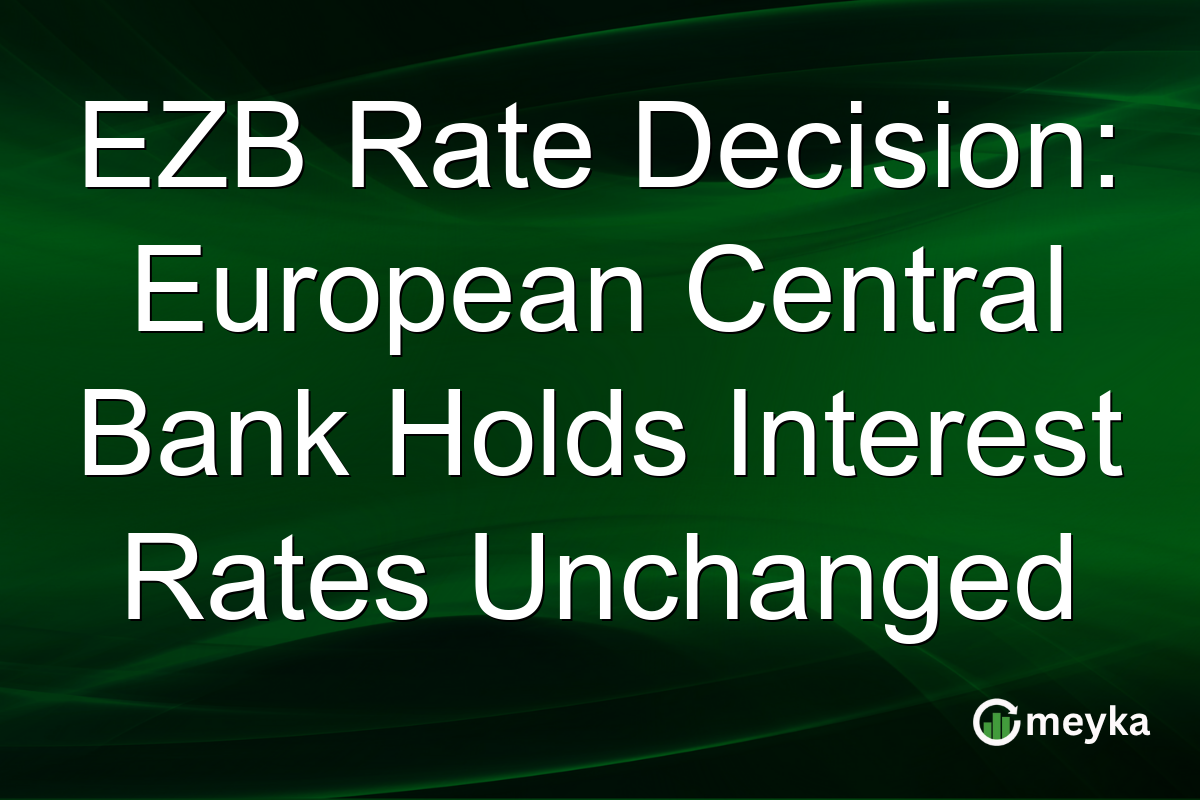EZB Rate Decision: European Central Bank Holds Interest Rates Unchanged
Today, on September 12, 2025, all eyes are on the European Central Bank (ECB) as the EZB Zinsentscheid 12.09.2025 was announced. The ECB has opted to keep its interest rates unchanged, a decision that speaks volumes about its current stance on economic policy. Let’s explore what this means for investors and the broader economic landscape in Europe. According to the ECB’s statement, this decision reflects their cautious outlook amid evolving economic indicators.
The Rationale Behind the Decision
The ECB’s decision to maintain the current rates is rooted in a complex economic environment characterized by fluctuating inflation rates and moderate growth across the Eurozone. By choosing not to increase or decrease rates at this moment, the ECB signals its intent to retain stability in financial markets. The rates remain at 0%, a position they have held for several quarters. This stability allows businesses and consumers to plan their financial strategies with a stable expectation, avoiding the shocks that a rate change might bring. The decision aligns with their previous assessments and is supported by recent data showing GDP growth in the Eurozone of 2.1% for the second quarter of 2025, a slight increase from 1.9% in the first quarter. This cautious growth rate illustrates a balanced yet slow-moving economy, a factor in the ECB’s decision. According to Stuttgarter Nachrichten, inflation remained stable at about 2.6%, aligning with ECB targets and providing further justification for a steady stance.
Market Reactions
The immediate market response to the EZB Zinsentscheid 12.09.2025 was relatively calm, with stock indices showing minor fluctuations. This reflects investor expectations that were largely attuned to the ECB’s consistent messaging leading up to this decision. Indices like the DAX and Euro Stoxx 50 remained stable, demonstrating that investors had already priced in the likelihood of the ECB’s steady approach. Such stability is crucial for maintaining investor confidence across the Eurozone. The long-term implications could include a sustained environment for investment growth, especially in sectors sensitive to interest rates like real estate and consumer goods. This encouraged positive analyst outlooks on certain equities, contributing to their upward revisions on growth estimates for 2025. Details from a LBBW report express that businesses continue to benefit from low borrowing costs, potentially boosting expansion plans.
Economic Implications
Holding interest rates steady often suggests a tactical pause, affording more time to assess the effectiveness of previous policy moves and the broader economic trends. The ECB’s careful consideration of this strategy reflects its understanding of the nuanced balance between stimulating growth and avoiding potential inflationary pressure. For consumers and businesses alike, this decision indicates that low-cost borrowing will persist, at least for the foreseeable future. Real estate markets may see continued growth, bolstered by affordable mortgage rates, which enhance buyer demand. Companies in capital-intensive industries also stand to benefit from cheaper financing options, promoting enhancements in infrastructure and technology. An article from Berlin Morgenpost states that this holding pattern could boost consumer spending confidence, ensuring stable retail growth and supporting overall economic output in key markets.
Looking Ahead: The ECB’s Future Strategie
Looking forward, the ECB’s strategy seems to balance caution with adaptability. Keeping rates unchanged allows for monitoring of real-time economic data, an approach aligning with their broader goal of stable inflation and supporting employment growth. Expectations for the latter part of 2025 include potential policy shifts should economic conditions warrant. The ECB has left the door open for future adjustments should inflation deviate significantly from its target zone. This flexibility ensures that the ECB can respond rapidly to unforeseen economic shifts without drastic disruptions. Meanwhile, platforms like Meyka provide investors with tools to analyze potential scenarios, leveraging real-time data analytics to make informed decisions. Keeping an eye on inflationary trends and employment data will be crucial for investors and policymakers alike as they navigate the remaining quarters of 2025.
Final Thoughts
The decision by the ECB to maintain the interest rates highlights their strategic patience amidst evolving economic indicators. With a focus on stability, it reassures the markets and sets a predictable financial environment, fostering continued investment and growth. As we look to the future, real-time analysis tools like those offered by Meyka are vital for investors striving to adapt and thrive within this stable yet dynamic economic landscape. This strategy ensures the ECB can respond to economic changes with precision and foresight.
FAQs
The ECB maintained rates to ensure stability in the Eurozone amid moderate GDP growth and controlled inflation, aligning with their economic forecasts.
Markets remained stable, with indices like the DAX and Euro Stoxx 50 showing minor fluctuations as investors had anticipated the decision based on prior ECB communications.
The decision allows for continued low borrowing costs, benefiting sectors like real estate and providing opportunities for business expansion and consumer spending.
Disclaimer:
This is for information only, not financial advice. Always do your research.






